Introduction
World War I marked a great surge in technological advancement in many areas, one of the most prominent being the weaponry used by both sides during the conflict. It acted as a proving ground or chance to refine many new armaments. In this article, we’ll be looking at a number of devices that were rolled out during World War I and II.
Flamethrower
Perhaps one of the most recognizable weapons for its combination of extravagance and destruction, the concept of the flamethrower is far older than World War I. Since times of old, one person has desired to launch flame at another. The Greeks in the 1st Century AD, speculated to be around 673, had invented such a method thanks to Kallinikos (Callinicus) of Heliopolis. It was known as “Greek Fire”.
In the past, soldiers used hand-pumps to shoot bursts of fire via a siphon-hose and piston, with a match at the end. Over 1000 years later, the general premise of the flamethrower has not changed much.
Firing Warsaw house by house by German firing units during and after the Warsaw Uprising. Warszawa 1945" Photoalbum, Warsaw 1985
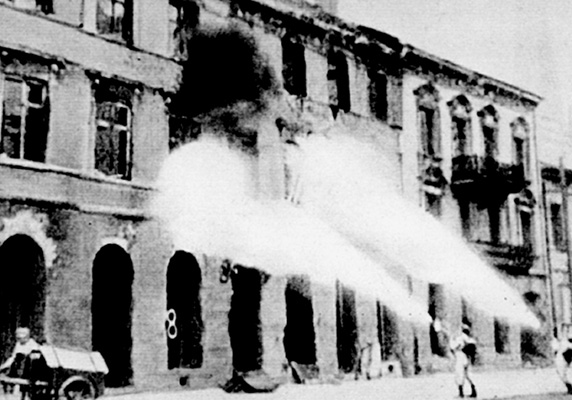
The English word “flamethrower” is a loan-translation of the German word Flammenwerfer because of the weapon’s Germanic origins. What we would call a flamethrower can be credited to Richard Fiedler, a German scientist. Though he submitted evaluation models in 1901, it was not until 1911 that the German army accepted their first real device, creating a specialist regiment of 12 Flammenwerferapparaten.
In World War I, the flamethrower was primarily utilized in trench warfare. It was in World War II the weapon saw most use. The Wehrmacht first deployed man-portable flamethrowers. Then, in 1942, the U.S. Army introduced its own version.
A Churchill Crocodile. By War Office official photographer Post-Work: User:W.wolny [Public domain]
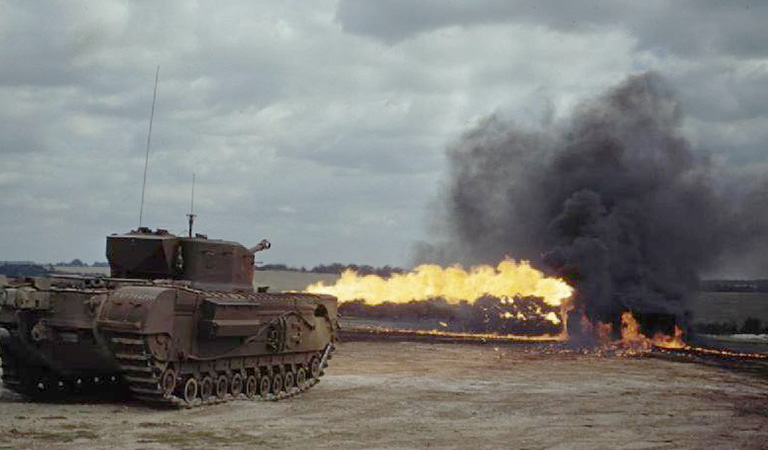
Also well-known and well-feared were experiments with tank-mounted flamethrowers across all sides during World War II. Germany had tanks such as the Flammpanzer and Panzer II Flamm, while Italy and Japan had the L3 Lf Flame tank and Type 95 Ha-Go, respectively. America had the M3 Satan and the United Kingdom had the Churchill Crocodile, to name a few.
However, the very nature of the flamethrower makes them very risky weapons. A soldier typically has to carry the backpack and the gun, which doesn’t give them a lot of maneuverability. Not to mention it’s pretty large, making them a clear target. Despite its hindrances, the flamethrower has become one of the most iconic weapons in warfare.
Sniper
In World War I, snipers were sharpshooters commonly used in trench warfare. The Imperial German army first utilized the units with scoped rifles at the advent of the war. Through each force had sharpshooters, German forces specifically used them to pick off any soldiers daring leave the safety of the trenches. It was only when French and British forces discovered these rifles that they knew they were not merely lucky shots. Because of their skill and high quality lenses, German snipers received quite the reputation.
In light of the German’s sniping force, the British mustered their own specialized unit. Major Hesketh Hesketh-Prichard founded the First Army School of Sniping, Observation, and Scouting in 1916. He took on many different recruits from several Allied nations.
German sniper using the Mauser 98k rifle with Russian PE scope mounted at Stalingrad. Bundesarchiv, Bild 169-0526 / CC-BY-SA [CC BY-SA 3.0]
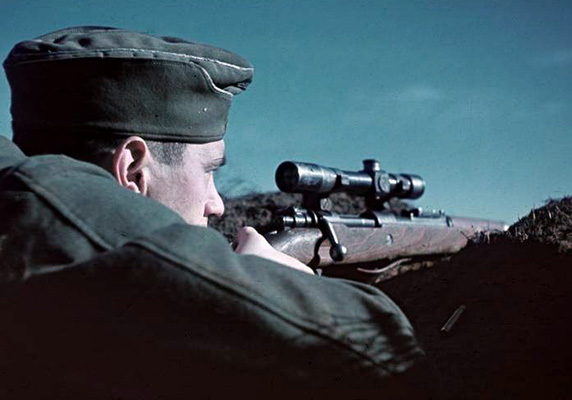
The most popular sniper rifles used by their respective nations were the German Mauser Gewehr 98; the British Pattern 1914 Enfield and Lee-Enfield SMLE Mk III, the Canadian Ross Rifle, the American M1903 Springfield, and the Russian M1891 Mosin-Nagant.
Despite a lull in the inter-war period, snipers were an integral part of the first campaign of World War II. Perhaps one of the most well-known battles with snipers was the Battle of Stalingrad. The Soviet snipers who took cover in the rubble-filled city were able to hold a strong defensive position and drive back Wehrmacht forces. After this battle, the Germans reinstated their specialized sniper training.
Grenades
Grenades, much like flamethrowers, have a history dating back over 1000 years. In the early to mid-700 BC (around the time of Greek Fire), simple incendiary grenades were used in the Eastern Roman (Byzantine) Empire. Also around this time in China, during the Song Dynasty, were weapons called Zhen Tian Lei (震天雷, “Sky-shaking Thunder”), where Chinese soldiers stuffed gunpowder into ceramic or metal containers.
Shortly before the start of World War I, grenades were still perceived as a liability. The British War Office in 1902 officially announced that hand grenades had become obsolete. However, just a couple of years later, the Board of Ordinance was tasked to develop of practical hand grenade.
Drawing of the Mills N°36 rifle grenade, with its cup (also known as “gas checker”). I, Jean-Louis Dubois [GFDL (http://www.gnu.org/copyleft/fdl.html), CC-BY-SA-3.0
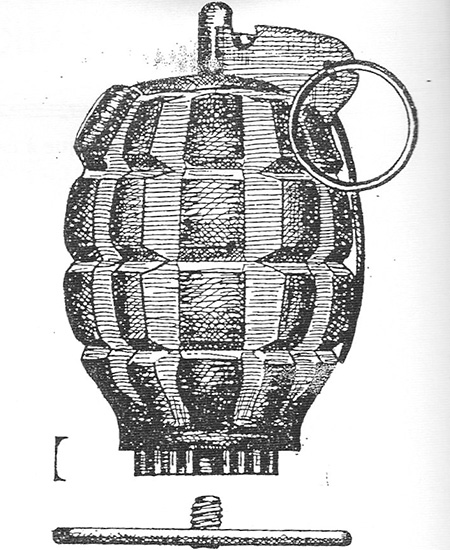
It would take several years for the grenade to be used in World War I. Marten Hale was unsuccessful in persuading the British Army to adopt the weapon until 1913. The Mills bomb was the first modern fragmentation grenade, which was used in the trenches from 1915.
There were around 75,000,000 grenades manufactured during World War I. These remained in use throughout World War II, as well. While the first grenade had a seven-second fuse, this was shortened after the Battle of France in 1940 after the delay gave troops enough time to flee the explosion or toss the grenade back.
Early Anti-Aircraft
Shortly before World War I broke out, the British saw the potential for anti-aircraft armaments. This began with the British government dotting the coasts of the British Isles with towers that were armed with special guns. This also applied to naval installations.
Soon other countries followed suit, extending to all armies involved in the conflict. However, the problem with these news forms of anti-aircraft defense was that very few had experience using them. When commonly employed on embankments and other ad-hoc locations, soldiers could not properly measure targets or get the trajectory correct.
During the inter-war years, the British Textbook of Anti-Aircraft Gunnery included five points for weaponry, which helped refine design methods.
American troops mount the Swedish Bofors 40mm anti-aircraft gun near the Algerian coastline in 1943. By Maurice, cap sur le Hoggar, de l'Atakor à la Taessa.Lecarteldz
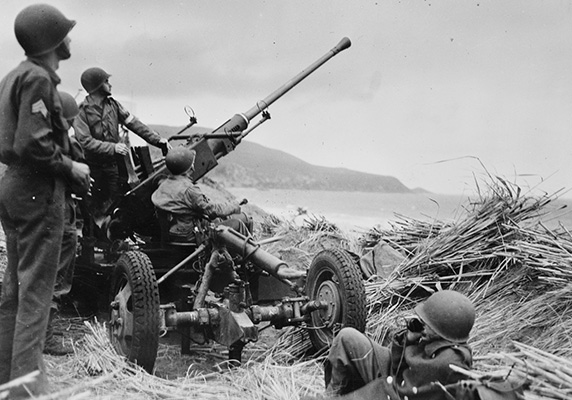
In World War II, the Battle of Britain in 1940 saw heavy anti-aircraft usage. Some time later, Germany’s Krupp’s engineers developed the FlaK 36, which was known as one of the best AA guns in the world. The gun was lethal against light, medium and even some heavy tanks.
When the dust had settled on the Dambusters raid in 1943, there was an emphasis on creating a new system capable of taking out low-flying aircraft in a single round. This new system involved a search and targeting radar, which made calculations and then sent electrical commands to the gun. Operators only had to select their target.
Tanks
What list wouldn’t be complete without mentioning tanks? The idea of a tank is an ancient concept. Who wouldn’t want to be able to make troops protected and mobile, while being able to dish out damage? The key innovations that led to the tank were the internal combustion engine, armor plating, and the continuous track.
For World War I, tanks were being developed separately and simultaneously by Great Britain and France. These armored vehicles were meant to break the deadlock of trench warfare on the Western Front. However, they were first rolled out by the British Army on September 15, 1916 during the Battle of the Somme.
Battle of Kursk was the largest tank battle ever fought, with each side deploying nearly 3,000 tanks. Bundesarchiv, Bild 101III-Merz-014-12A / Merz / CC-BY-SA [CC BY-SA 3.0
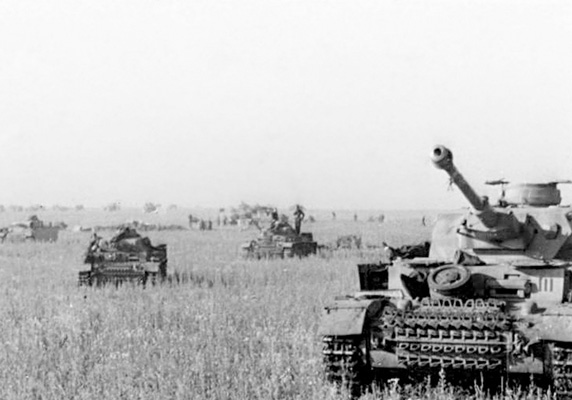
The name “tank” was first used for British “landships” in 1915 in an effort to keep their nature a secret before they entered combat. There are a few explanations as to where it originates:
- Workmen in British factories who were constructing the hulls of tanks were told they were making water tanks in an effort to keep their nature secret and throw off possible spies.
- The term “tank” was first used in a secret report on a new motorized weapon by Winston Churchill.
- One biography of Winston Churchill says that, in order to disguise the vehicles, they were labeled as “water carriers for Russia”, which may have changed to “water tanks”.
Though Britain and France constructed thousands of tanks between them, Germany, who were still skeptical, built only around 20.
Tiger II's of Schwere Heeres Panzer Abteilung 503 (s.H.Pz.Abt. 503) 'Feldherrnhalle' posing in formation for the German newsreel. Bundesarchiv, Bild 146-1975-102-14A / Hamann / CC-BY-SA [CC BY-SA 3.0
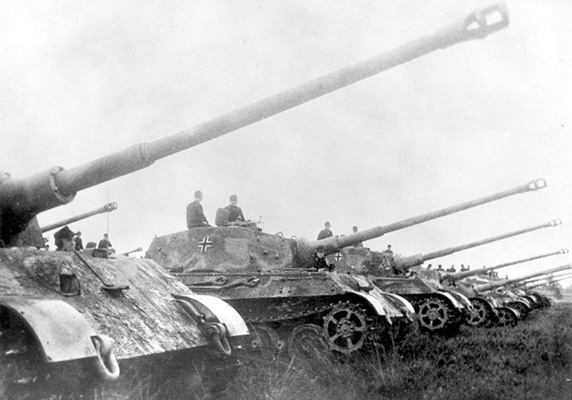
Tank tactics evolved quickly during World War I and encountered problems like fragmentary deployment, mechanical issues and poor mobility lessened the impact of the tank in the conflict. Despite its intended role in trench warfare, the tank was unable to fulfill its mission of rendering it obsolete. However, all sides recognized the significance of the vehicles and its role in years to come.